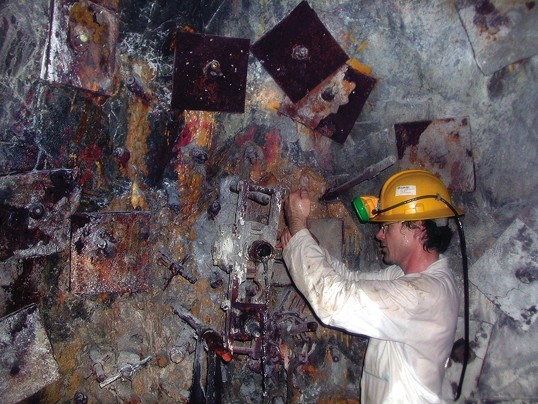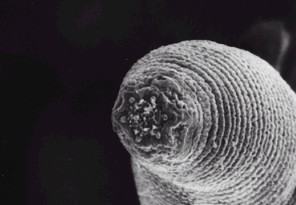“We can now say that worlds with such
subsurface environments could, in theory,
harbor subsurface life, both microbial and
multicellular,” Pilcher said. “That
knowledge . . . can help guide
us in developing missions and experiments to
study other worlds.”
At least one of the bacteria species
discovered earlier by Onstott and Lisa Pratt
of Indiana University lives entirely
disconnected from anything on the Earth’s
surface or produced by photosynthesis. It
uses the radioactive decay of nearby rocks
as the energy source to break apart
molecules that it then feeds on.
Borgonie speculates that the nematodes,
which feed on bacteria, traveled through the
cracks and crevices of rock in search of
food. While they were determined to have
lived deep underground for 3,000 to 10,000
years, the bacteria discovered by Onstott
was found to have lived at its great depth
between 3 million and 40 million years. A
major difference between the two appears to
be that while the nematodes adapted, the
bacteria have evolved.
Complete worms, up to one-third of an
inch in length, were found in two mines, and
DNA of another was found in a third. They
were found in water flowing from boreholes
in the rock of the mines at depths from
two-thirds of a mile to more than two miles.
The worms nearer the surface were brought to
a lab and survived, while the specimen at
the deepest level was a DNA sample from a
nematode but otherwise impossible to
identify.
A primary hurdle the team had to overcome
was proving that the nematodes had not come
into the mines on the shoes or clothing of
miners or through mine ventilation water.
The contamination issue was resolved through
extensive testing of the soil and mining
water, which contains two disinfectant
bleaches that would kill nematodes.
Borgonie, working with a team from South
Africa’s University of the Free State in
Bloemfontein, descended into the deep mines
about 25 times to collect samples. He said
there is good reason to believe nematodes,
and other multi-celled organisms, also live
deep below the surface of many other parts
of the world, and especially below ocean
beds.
Research into the distribution of
underground microbes in recent decades has
led scientists to conclude that more than
half of the biological mass on Earth is
below the surface.
Return to "In the News - 2011"
Go to Nemaplex Home Page

